Walhalla memorial
The Walhalla is a hall of fame that honors laudable and distinguished people in German history – "politicians, sovereigns, scientists and artists of the German tongue";[1] thus the celebrities honored are drawn from Greater Germany, a wider area than today's Germany, and even as far away as Britain in the case of several Anglo-Saxons who are honored. The hall is a neo-classical building above the Danube River, east of Regensburg in Bavaria.
The Walhalla is named for the Valhalla of Norse mythology. It was conceived in 1807 by Crown Prince Ludwig in order to support the then-gathering momentum for the unification of the many German states. Following his accession to the throne of Bavaria, construction took place between 1830 and 1842 under the supervision of the architect Leo von Klenze. The memorial displays some 65 plaques and 130 busts covering 2,000 years of history, beginning with Arminius, victor at the Battle of the Teutoburg Forest in 9 AD.
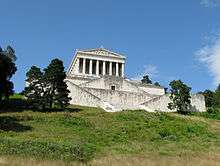
History

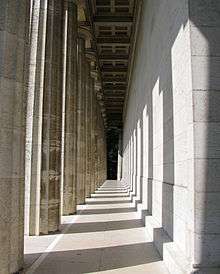

By 1806 Napoleon's First French Empire had annexed German lands along the Rhine River and the North Sea. Central German states formed the Confederation of the Rhine, which sided with Napoleon. Francis II, Holy Roman Emperor, then formally dissolved the Holy Roman Empire of the German Nation (6 August 1806) and instead styled himself Emperor of Austria. The War of the Fourth Coalition (1806-1807) pitted German forces on both sides against each other, and Napoleon again prevailed.
In 1807, 20-year-old Crown Prince Ludwig of the Kingdom of Bavaria (newly elevated from Electorate to Kingdom by Napoleon in 1806), had the idea of reminding all Germans of their common heritage – of the great figures and events in ethnic German history. He commissioned several sculptors to create busts of famous individuals of his choice. Johann Gottfried Schadow's bust of Nicolaus Copernicus became one of the first completed, in 1807. Further suggestions for individuals to be honored were solicited in 1808 from Swiss historian Johannes von Müller.
By the time of Crown Prince Ludwig's coronation as King Ludwig I of Bavaria in 1825, 60 busts had been completed. In 1826 Ludwig commissioned the construction of a memorial above the Danube River, near Regensburg, modeled after the Parthenon in Athens. The southern pediment frieze features the 1815 creation of the German Confederation; the northern, scenes from the Battle of the Teutoburg Forest of 9 AD.[2] According to Pictorial Travels Continentally Described (circa 1892), the construction of the building cost £666,666.
A two thaler coin was minted commemorating the opening of the Walhalla, Krause catalog number KM# 811. It is moderately scarce.[3]
At Walhalla's inauguration on October 18, 1842, there were 96 busts, plus 64 plaques for persons or events of which no portrait was available on which to model a sculpture. As being "of the German tongue" was the main selection criterion for the original 160 persons representing the 1,800 years of German history, the King included persons from, or who had been active in, modern-day Sweden, Austria, Czech Republic, Poland, United Kingdom, Belgium, Netherlands, Russia, Switzerland and the Baltic States.
Whereas the Valhalla of Norse mythology served as home to those gloriously slain in battle, Ludwig intended his Walhalla not only for warriors but also for scientists, writers, and clerics, and specifically included both men and women. Decades before the foundation of the modern German state in 1871, "German" was understood as "Germanic", and included Gothic, Langobardic, Anglo-Saxon, Austrian, Dutch and Swiss German figures, as well as persons who had gained fame mainly in non-German-speaking contexts.
Beginning in 1933, when Kraft durch Freude and other National Socialist organizations promoted trips to Walhalla, visitor numbers increased exponentially. In 1937, when Hitler unveiled a Bruckner bust, 131,520 were counted. In April 1945, General George Smith Patton, Jr. stood there, as men of his 3rd Army were crossing the Danube River.[4]
As successor to the King, the government of Bavaria decides on additions. Anyone may propose a name, but candidates must have died at least 20 years before becoming eligible (doubled in 1912). Only 31 busts have been added since its opening, on an irregular basis, for a total of 191, twelve of them female. A number of the additions since the Second World War are of people who had been opposed to the National Socialists, and an especially prominent place at the end of the series is allotted to Sophie Scholl, a Munich student who was executed in 1943 for her non-violent resistance to Hitler's régime.
In Munich, King Ludwig I established an additional Hall of Fame for Bavarians in 1853 – the Ruhmeshalle München. Nine of the Bavarian enshrinees have since become Walhalla enshrinees. Thus, their busts in the Ruhmeshalle, which were destroyed in 1944 during World War II, have not been recreated. Instead, a plaque with their names tells of their transfer to Walhalla. King Ludwig I himself, who commissioned the Befreiungshalle and other monuments, was also enshrined both at Walhalla and in the Ruhmeshalle.
List of people
Commemorative plaques
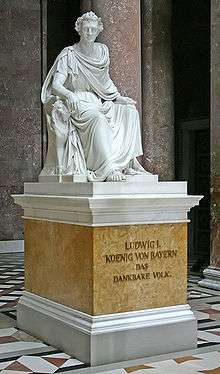

Plaques were made for people (or acts) of which no portraits or descriptions were available to model sculptures after. The timeline spans from Arminius a.k.a. Hermann der Cherusker (born 17 BC) to watchmaker Peter Henlein, who died in 1542. In 2003 a plaque was added to commemorate well-known and unknown German Resistance fighters against Nazi Germany.
- Alaric I – king of the Visigoths
- Albertus Magnus – philosopher and theologian
- Alboin – king of the Lombards
- Alfred the Great – King of Wessex
- Alcuin – Charlemagne's leading advisor on ecclesiastical and educational affairs
- Arnulf of Carinthia – Holy Roman Emperor
- Arnulf, Duke of Bavaria – Arnulf the Bad, confiscated church property for defense
- Athaulf – king of the Visigoths
- Bede – English monk and scholar
- Bernward of Hildesheim – Bishop of Hildesheim
- Saint Boniface – Patron saint of Germany
- Adrian von Bubenberg – Swiss knight and general
- Clovis I – King of the Franks
- Julius Civilis (* 25), leader of Germanic rebellion against Rome in 69
- Egbert of Wessex (770–839), considered the first de facto King of England, grandfather of Alfred the Great
- Eginhard – historian
- Elisabeth of Hungary – Saint and Hungarian princess
- Emmeram of Regensburg – Saint
- Engelbert II of Berg – Saint
- Friediger
- Frederick I of Austria (Habsburg) Duke of Austria and King of the Romans
- Geiseric – King of the Vandals and Alans
- Gerhard von Rile – architect of the Cologne Cathedral
- Peter Henlein – inventor of the watch
- Henry III, Holy Roman Emperor
- Hengest – leader of the Germanic invasion of Britain in the 5th century
- Heribert of Cologne – Archbishop of Cologne and Chancellor of Emperor Otto III
- Ermanaric – King of the Ostrogoths
- Hermann der Cherusker – victor in the Battle of Teutoburg Forest
- Hermann von Salza – fourth Grand Master of the Teutonic Knights
- Hildegard von Bingen a German magistra, monastic leader, mystic, author, and composer of music.
- Horsa – warrior, and brother of Hengest
- Hrosvit – a twelfth century canoness, Latin language poet, and pioneer dramatist of Gandersheim Abbey, Lower Saxony
- Charles Martel – the Hammer, defeated the Arabs at the Battle of Tours
- Charlemagne – founder of the Holy Roman Empire
- Lambrecht von Aschaffenburg
- Leopold VI, Duke of Austria
- Marbod – king of the Marcomanni
- Mechtilde – Saint
- The writer of the Nibelungenlied
- Odoacer – chieftain of the Germanic, deposed the last Western Roman Emperor
- Otto II Wittelsbach, Duke of Bavaria
- Otto of Bamberg – canonized medieval German bishop who as papal legate converted much of Pomerania to Christianity.
- Otto of Freising – Bishop of Freising
- Otto I Wittelsbach, Duke of Bavaria
- Pippin of Herstal, Mayor of the Palace
- Pippin the Younger, Mayor of the Palace
- Rabanus Maurus, Benedictine monk, archbishop of Mainz
- The three of the Rütli-Schwur (Swiss confederation)
- Theudelinde
- Theodoric I – King of the Visigoths
- Theodoric the Great, king of the Ostrogoths and of the Visigoths
- Arnold zum Turm
- Totila, king of the Ostrogoths
- Ulfilas, Gothic bishop, missionary, and translator.
- Veleda, prophetess of the Bructeri during the Batavian rebellion
- Walther von der Vogelweide, celebrated poet of Middle High German lyric
- Bruno von Warendorp – mayor of Lübeck
- Paul Warnefried – Paul the Deacon
- Meister Wilhelm von Köln
- Saint Willibrord, Northumbrian missionary, known as the Apostle to the Frisians
- Arnold von Winkelried, hero of the Swiss
- Widukind – duke of Saxony and antagonist of Charlemagne during the Saxon Wars
- Wolfram von Eschenbach, a German knight, Minnesinger and epic poet
- Widerstand – German Resistance fighters against Nazi Germany. Added in 2003
Busts
The original busts are arranged in rows by date of death, beginning with Henry the Fowler (born 876 AD) and ending with Goethe (died 1832).
Original busts (before 1847)
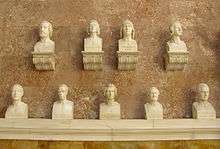

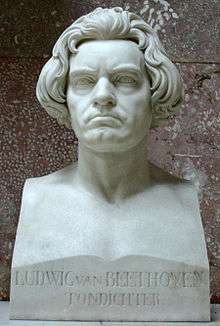
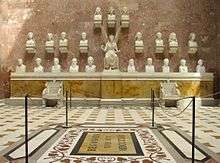

- Amalie Elisabeth – Countess of Hesse-Kassel during the Thirty Years' War
- August II the Strong – Elector of Saxony and King of Poland
- Michael Andreas Barclay de Tolly – Russian Field Marshal from Baltic German family of Scottish descent
- Ludwig van Beethoven – German composer from the classical period
- Bernhard of Saxe-Weimar – general in the Thirty Years' War
- Gebhard Leberecht von Blücher – Prussian Generalfeldmarschall
- Herman Boerhaave – Dutch humanist and physician
- Gottfried August Bürger – poet
- Christoph, Duke of Württemberg – Duke of Württemberg
- Johann von Dalberg – Bishop of Worms
- Hans Karl von Diebitsch – Russian field marshal, born in Silesia
- Albrecht Dürer – printmaker and painter
- Anthony van Dyck – Flemish painter and etcher
- Eberhard I. of Württemberg – Duke of Württemberg
- Julius Echter von Mespelbrunn – Bishop of Würzburg
- Joseph Freiherr von Eichendorff – poet
- Erasmus of Rotterdam – Dutch humanist
- Ernst I – Duke of Saxe-Gotha and Saxe-Altenburg during the Thirty Years' War
- Jan van Eyck – Flemish painter
- Karl Wilhelm Ferdinand, Duke of Brunswick-Lüneburg – Prussian Generalfeldmarschall
- Frederick I, Elector Palatine – the Victorious, Elector of the Palatinate
- Frederick I, Holy Roman Emperor – Barbarossa
- Frederick II, Holy Roman Emperor – Stupor mundi
- Frederick II of Prussia – Frederick the Great
- Frederick William, Elector of Brandenburg – the Great Elector
- Georg von Frundsberg – Knight and leader of Landsknechts
- Jakob Fugger – the Rich, merchant in Augsburg
- Ernst Gideon Freiherr von Laudon – Austrian field marshal from Livonia
- Christoph Willibald Gluck – composer
- Johann Wolfgang von Goethe – poet and polymath
- Johann Joseph von Görres – writer
- Hugo Grotius – Dutch jurist
- Otto von Guericke – German scientist and inventor
- Johannes Gutenberg – inventor of movable type
- Albrecht von Haller – Swiss anatomist and physiologist
- Hans von Hallwyl – Swiss commander at the Battle of Morat
- Georg Friedrich Händel – German baroque composer
- Joseph Haydn – Austrian composer from the classical period
- Henry the Lion – Duke of Saxony and Bavaria
- Henry the Fowler – Duke of Saxony and King of the Germans
- Johann Jakob Wilhelm Heinse – German author
- Berthold von Henneberg – Elector and Archbishop of Mainz
- Johann Gottfried Herder – German poet, critic, and theologian
- Friedrich Wilhelm Herschel – German astronomer and composer
- Hans Holbein the Younger – German painter
- Ulrich von Hutten – German knight and Renaissance humanist
- Friedrich Ludwig Jahn – German patriot and father of gymnastics
- Immanuel Kant – German philosopher from the classical period
- Archduke Charles of Austria – Austrian military commander
- Charles V, Holy Roman Emperor
- Charles V, Duke of Lorraine
- Charles X Gustav of Sweden – King of Sweden
- Catherine II of Russia, Catherine the Great – Tsarina of Russia
- Johannes Kepler – German mathematician and astronomer
- Friedrich Gottlieb Klopstock – German poet
- Conrad II, Holy Roman Emperor
- Nicolaus Copernicus – Astronomer; the first to thoroughly calculate a heliocentric model of the universe
- Gottfried Wilhelm Leibniz – German philosopher and mathematician
- Gotthold Ephraim Lessing – German poet from the age of enlightenment
- Justus von Liebig – German chemist
- Paris Graf von Lodron – Archbishop of Salzburg
- Ludwig Wilhelm von Baden – Türkenlouis, Imperial commander
- Ludwig I – King of Bavaria
- Maria Theresia – Archduchess of Austria and Queen of Hungary and Bohemia
- Maximilian I, Holy Roman Emperor
- Maximilian I – Prince-elector of Bavaria
- Hans Memling – Flemish painter
- Raphael Mengs – Bohemian painter
- Maurice of Orange – Dutch captain-general of the army of the Dutch Republic
- Maurice of Saxony – German commander and military strategist
- Justus Möser – German historian
- Wolfgang Amadeus Mozart – Austrian composer from the classical period
- Johannes Müller (Regiomontanus) – German astronomer and mathematician
- Johannes von Müller – Swiss historian
- Burkhard Christoph Graf von Münnich – German field marshal in Russian service
- August Graf Neidhardt von Gneisenau – Prussian field marshal
- Nicholas of Flue – Swiss hermit, ascetic and mystic
- Otto I, Holy Roman Emperor
- Theophrast von Hohenheim Paracelsus – 17th century Swiss physician and alchemist
- Jean Paul – German humorist
- Max von Pettenkofer – German chemist and hygienist
- Wolter von Plettenberg – German Master of the Livonian Brothers of the Sword
- Johannes von Reuchlin – German philosopher and humanist
- Peter Paul Rubens – Flemish painter
- Rudolf I of Habsburg – German king
- Michiel Adriaenszoon de Ruyter – Dutch admiral
- Gerhard von Scharnhorst – Prussian general
- Friedrich Wilhelm Joseph von Schelling – German philosopher
- Friedrich von Schiller – German poet and exponent of Sturm und Drang
- Johann Philipp von Schönborn – Archbishop and Prince-elector of Mainz
- Karl Philipp Fürst zu Schwarzenberg – Austrian field marshal
- Franz von Sickingen – leader of the knighthood in Rhineland and Swabia
- Frans Snyders – Flemish painter
- Karl vom und zum Stein – Prussian politician
- Erwin von Steinbach – German architect of the Straßburger Münster
- Adalbert Stifter – Austrian author
- Johannes Aventinus (Johann Georg Turmair) – Bavarian scholar and historian
- Maximilian von und zu Trauttmansdorff – Austrian diplomat that negotiated the Peace of Westphalia
- Maarten Harpertszoon Tromp – Dutch admiral
- Aegidius Tschudi – Swiss composer
- Peter Vischer the elder – German Sculptor
- Albrecht von Wallenstein – Bohemian general in the Thirty Years' War
- Christoph Martin Wieland – German Poet
- Wilhelm Graf zu Schaumburg-Lippe – Commander of his army in the Seven Years' War and for Portugal
- William I of Orange – Dutch leader of the Eighty Years' War for the Dutch independence from Spain
- William III of Orange – Dutch Stadtholder and king of England, Scotland, and Ireland
- Johann Joachim Winckelmann – German archeologist and art writer
- Nikolaus Ludwig von Zinzendorf – German religious and social reformer, bishop of the Moravian Church
- ...
- ...
- William III of England (Haller, 1816)
- Louis William, Margrave of Baden-Baden (Widnmann, 1842)
- Gottfried Wilhelm Leibniz (Schadow, 1808)
- Herman Boerhaave (Leeb, 1823)
- Maurice de Saxe – German officer and Marshal General of France (Tieck, 1813)
- Georg Friedrich Händel (R. Schadow, 1815)
- ...
- ...
- ...
- ...
- Nikolaus Ludwig von Zinzendorf (Tieck, 1818)
- Burkhard Christoph von Münnich (Lossow, 1841)
- Johann Joachim Winckelmann (R. Schadow, 1814)
- William, Count of Schaumburg-Lippe (Schadow, 1809)
- Albrecht von Haller (Schadow, 1809)
- Anton Raphael Mengs (Rauch, 1808)
- Maria Theresia
Later additions (after 1847)

- sorted chronologically by year of addition
- Martin Luther (1848) – Leader of the Protestant Reformation, translator of the Bible into German; Heinrich Heine had remarked upon this omission.
- Josef Wenzel Graf Radetzky von Radetz (1853) – Bohemian military leader
- Wilhelm I (1898) – German Emperor
- Otto von Bismarck (1908) – Chancellor of North German Confederation and then of the German Empire
- Helmuth Graf von Moltke (1910) – German Generalfeldmarschall
- Richard Wagner (1913) – German composer of operas
- Johann Sebastian Bach (1916) – composer
- Franz Peter Schubert (1928) – Austrian Romantic composer
- Anton Bruckner (1937) – Austrian composer
- Max Reger (1948) – German composer and organist of the late romantic period
- Wilhelm Conrad Röntgen (1959) – German physicist
- Richard Strauss (1973) – German composer
- Carl Maria von Weber (1978) – German composer
- Gregor Joh. Mendel (1983) – Silesian Augustinian monk and naturalist[5]
- Albert Einstein (1990) – physicist
- Karolina Gerhardinger (1998) – founder of the School Sisters of Notre Dame
- Konrad Adenauer (1999) – first Chancellor of West Germany
- Johannes Brahms (2000) – Composer
- Sophie Scholl (2003) – German passive resistance activist against the Nazi regime.[6]
- Carl Friedrich Gauss (2007) – mathematician, astronomer, and physicist[7]
- Edith Stein (2008) – philosopher and saint
- Heinrich Heine (2009) – German Romantic poet
Song for the opening of Walhalla memorial
When the memorial was opened in 1842, Joseph Hartmann Stuntz authored a poem about Germany's greatness which was set to music by Joseph Hartmann Stuntz.[8] The lyrics are:
| German[9] | English |
|---|---|
I. |
I. |
Teutscher Brust entströmen Lieder, |
Songs arise from the German bosom, |
Teutsch begrüßt er teutsche Helden, |
It greets, in German manner, German heroes |
II. |
II. |
Hier die Manen hehrer Krieger |
The manes of noble warriors |
Diesen Kern aus altem Stamme, |
This is the core of our old tribes |
III. |
III. |
Ihr erblickt auch hier Gestalten, |
You will see here people, too, |
Von den Blüthen, Teutschland, pflücke |
Pick, Germany, from these blossom |
See also
| Wikimedia Commons has media related to Walhalla. |
- Befreiungshalle (Hall of Liberation, Kelheim, Germany)
- Heldenberg Memorial (in Austria)
- Hermannsdenkmal (Hermann monument, Teutoburg Forest, Germany)
- Ruhmeshalle (Hall of Fame, Munich, Germany)
Literature
- Walhalla, official guide booklet, translated by Helen Stellner and David Hiley, Bernhard Bosse Verlag Regensburg, 2002
- Eveline G. Bouwers, Public Pantheons in Revolutionary Europe. Comparing Cultures of Remembrance, c. 1790-1840, Basingstoke 2012, pp. 161-212 (ISBN 978-0-230-29471-4)
- Adalbert Müller: Donaustauf and Walhalla (1846) at archive.org
References
- ↑ Official Guide booklet, 2002, p. 3
- ↑ Official Guide booklet, 2002, p. 6
- ↑ German States BAVARIA 2 Thaler KM# 811 1842
- ↑ Anna Rosmus Hitlers Nibelungen, Samples Grafenau 2015, p. 178
- ↑ Hynčice lie in Silesia.
- ↑ The bust of Sophie Scholl was inaugurated on February 22, 2003, the 60th anniversary of her execution. It is also intended as a representative of all the members of the Widerstand (the German Resistance against Nazi Germany), who have been honored with an additional plaque.
- ↑ http://www.stmwfk.bayern.de/downloads/aviso/2004_1_aviso_48-49.pdf
- ↑ Institute of Bavarian History
- ↑ Oesterreichischer Beobachter auf das Jahr 1842. Zweiter Band Juli bis Ende December. Wien: 1842, p. 1,176.
External links
| Look up Walhalla in Wiktionary, the free dictionary. |
- Walhalla official website
- New York Times: Two Temples To the Greats Of Germany, 1988
Coordinates: 49°01′53.35″N 12°13′26.72″E / 49.0314861°N 12.2240889°E
